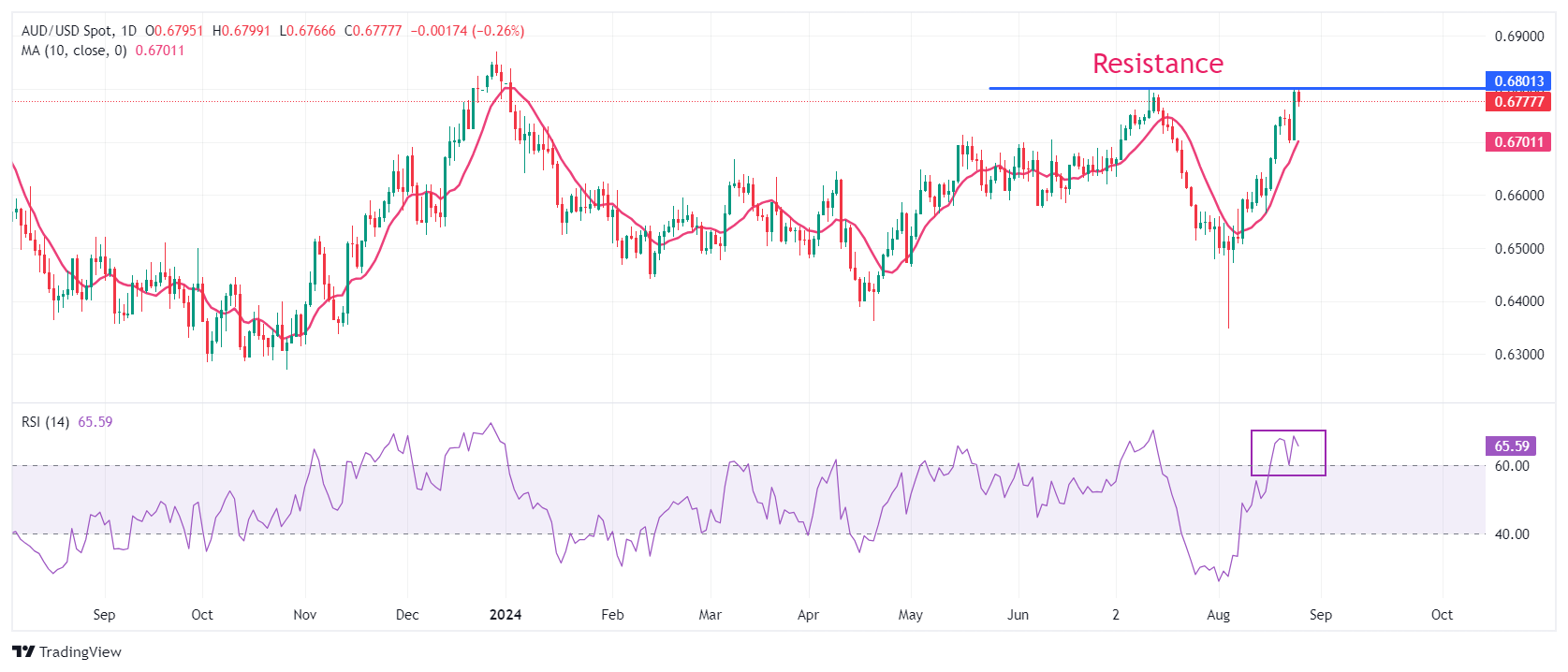- AUD/USD falls from 0.6800 with Australian inflation in focus.
- The Fed appears set to begin cutting interest rates as early as September.
- The short-term outlook for the US Dollar remains weak.
The AUD/USD pair is down from the monthly high of 0.6800 in the American session on Monday. The Australian asset is falling while the US Dollar (USD) is rising. Although the short-term outlook for the US Dollar remains vulnerable as the Federal Reserve (Fed) is widely anticipated to start cutting interest rates from the September meeting.
The US Dollar Index (DXY), which tracks the greenback’s value against six major currencies, is up slightly near 100.90 from a yearly low of 100.53.
While the Fed appears confident of cutting interest rates in September, traders are divided on the likely size. According to the CME FedWatch tool, 30-day federal funds futures price data show the probability of a 50 basis point (bps) interest rate cut is 36.5%, while the rest of the bets are in favor of a 25 bps rate cut.
Meanwhile, the Australian Dollar (AUD) will be influenced by the monthly Consumer Price Index (CPI) data for July, due out on Wednesday. Economists estimated that price pressures eased sharply to 3.4% from 3.8% in June. An expected decline in inflation data would bring expectations of interest rate cuts to the table.
The AUD/USD pair is trading near the monthly high of 0.6800 on a daily time frame. The short-term outlook for the Australian asset remains firm as the 10-day exponential moving average (EMA) near 0.6700 is sloping upward. The 14-period Relative Strength Index (RSI) is oscillating in the bullish range of 60.00-80.00, suggesting strong upside momentum.
For a fresh upside, a decisive move above the round-level resistance of 0.6800 will push the asset towards 0.6840, the highest level seen this year. A break of the latter would take the asset towards the December 2023 high of 0.6870.
In an alternative scenario, a downside move below the August 19 low of 0.6660 will expose the asset to the June 28 low of 0.6620 and the June 17 low of 0.6585.
AUD/USD daily chart
Australian Dollar FAQs
One of the most important factors for the Australian Dollar (AUD) is the level of interest rates set by the Reserve Bank of Australia (RBA). Since Australia is a resource-rich country, another key factor is the price of its largest export, iron ore. The health of the Chinese economy, its largest trading partner, is a factor, as is inflation in Australia, its growth rate and the Trade Balance. Market sentiment, i.e. whether investors are betting on riskier assets (risk-on) or seeking safe havens (risk-off), is also a factor, with risk-on being positive for the AUD.
The Reserve Bank of Australia (RBA) influences the Australian Dollar (AUD) by setting the level of interest rates that Australian banks can lend to each other. This influences the level of interest rates in the economy as a whole. The RBA’s main objective is to maintain a stable inflation rate of 2%-3% by adjusting interest rates up or down. Relatively high interest rates compared to other major central banks support the AUD, and the opposite for relatively low ones. The RBA can also use quantitative easing and tightening to influence credit conditions, with the former being negative for the AUD and the latter positive for the AUD.
China is Australia’s largest trading partner, so the health of the Chinese economy greatly influences the value of the Australian Dollar (AUD). When the Chinese economy is doing well, it buys more raw materials, goods and services from Australia, which increases demand for the AUD and drives up its value. The opposite occurs when the Chinese economy is not growing as fast as expected. Therefore, positive or negative surprises in Chinese growth data often have a direct impact on the Australian Dollar.
Iron ore is Australia’s largest export, worth $118 billion per year as of 2021 data, with China being its main destination. The price of iron ore can therefore be a driver of the Australian dollar. Typically, if the price of iron ore rises, the AUD rises as well, as aggregate demand for the currency increases. The opposite occurs when the price of iron ore falls. Higher iron ore prices also tend to lead to a higher probability of a positive trade balance for Australia, which is also positive for the AUD.
The trade balance, which is the difference between what a country earns from its exports and what it pays for its imports, is another factor that can influence the value of the Australian dollar. If Australia produces highly sought-after exports, its currency will gain value solely because of the excess demand created by foreign buyers wanting to purchase its exports versus what it spends on buying imports. Therefore, a positive net trade balance strengthens the AUD, with the opposite effect if the trade balance is negative.
Source: Fx Street
I am Joshua Winder, a senior-level journalist and editor at World Stock Market. I specialize in covering news related to the stock market and economic trends. With more than 8 years of experience in this field, I have become an expert in financial reporting.








